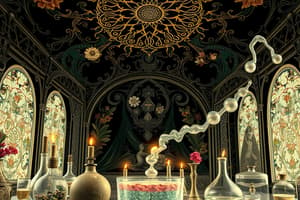Podcast
Questions and Answers
Which of the following statements about solubility of ionic compounds is correct?
Which of the following statements about solubility of ionic compounds is correct?
- All carbonates are soluble in water.
- Most nitrates are insoluble in water.
- Barium sulfate is soluble in water.
- Common chlorides are soluble except for those of silver and lead II. (correct)
Calcium carbonate is soluble in water.
Calcium carbonate is soluble in water.
False (B)
What color does lithium ion (Li+) produce in a flame test?
What color does lithium ion (Li+) produce in a flame test?
red
To test for the presence of sulfate ions (SO4 2-), you would use ___________ chloride solution.
To test for the presence of sulfate ions (SO4 2-), you would use ___________ chloride solution.
Match the cation with its flame test color:
Match the cation with its flame test color:
Flashcards are hidden until you start studying
Study Notes
Solubility Rules for Ionic Compounds
- Most sodium, potassium, and ammonium compounds are soluble in water.
- All nitrates are soluble in water.
- Most chlorides are soluble in water, except for silver chloride (AgCl) and lead(II) chloride (PbCl2).
- Most sulfates are soluble in water, except for barium sulfate (BaSO4), calcium sulfate (CaSO4), and lead(II) sulfate (PbSO4).
- Most carbonates are insoluble in water, except for those of sodium, potassium, and ammonium. Calcium carbonate (CaCO3) is slightly soluble.
Preparing a Pure, Dry Sample of a Soluble Salt
- Start with an insoluble reactant.
- React the insoluble reactant with a suitable reagent to form a soluble salt.
- Filter the mixture to remove any insoluble residue.
- Crystallize the soluble salt by evaporating the solvent.
- Dry the crystals thoroughly to remove any residual solvent.
Flame Tests
- Use a Bunsen burner.
- Dip a clean wire loop into the solution of the unknown cation.
- Place the loop in the non-luminous flame.
- Observe the color of the flame produced.
Flame Test Colors
- Lithium (Li+) produces a red flame.
- Sodium (Na+) produces a yellow flame.
- Potassium (K+) produces a lilac flame.
- Calcium (Ca2+) produces an orange-red flame.
- Copper(II) (Cu2+) produces a blue-green flame.
Cation Tests
- Ammonium (NH4+): Add sodium hydroxide solution to a sample of the unknown solution. A pungent ammonia gas (NH3) is produced, which can be detected by its characteristic smell.
- Copper(II) (Cu2+): Add sodium hydroxide solution to a sample of the unknown solution. A blue precipitate of copper(II) hydroxide (Cu(OH)2) is formed.
- Iron(II) (Fe2+): Add sodium hydroxide solution to a sample of the unknown solution. A green precipitate of iron(II) hydroxide (Fe(OH)2) is formed, which quickly oxidizes to a brown precipitate of iron(III) hydroxide (Fe(OH)3) in air.
- Iron(III) (Fe3+): Add sodium hydroxide solution to a sample of the unknown solution. A brown precipitate of iron(III) hydroxide (Fe(OH)3) is formed.
Anion Tests
- Chloride (Cl-), Bromide (Br-), Iodide (I-): Add acidified silver nitrate solution to a sample of the unknown solution. White precipitate of silver chloride (AgCl), cream precipitate of silver bromide (AgBr), and yellow precipitate of silver iodide (AgI) are formed, respectively.
- Sulfate (SO42-): Add acidified barium chloride solution to a sample of the unknown solution. A white precipitate of barium sulfate (BaSO4) is formed.
- Carbonate (CO32-): Add hydrochloric acid to a sample of the unknown solution. Carbon dioxide gas (CO2) is evolved, which can be detected by its effervescence and by passing the gas through limewater, which turns cloudy.
Studying That Suits You
Use AI to generate personalized quizzes and flashcards to suit your learning preferences.




